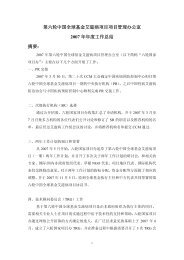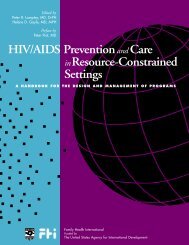The Training of Trainers Manual - UNFPA
The Training of Trainers Manual - UNFPA
The Training of Trainers Manual - UNFPA
Create successful ePaper yourself
Turn your PDF publications into a flip-book with our unique Google optimized e-Paper software.
Day 5<br />
■ Peer educators should be expected to work independently, contacting their<br />
supervisors rarely.<br />
■ Most peer educators leave a program because they do not feel appreciated by<br />
their organizations.<br />
After you have read the first statement, the participants should go to the spot that<br />
best describes their response to it. When they are all standing somewhere along<br />
the line, ask a volunteer to explain why he or she is standing there. Ask participants<br />
to provide examples <strong>of</strong> the types <strong>of</strong> financial and non-financial incentives that can<br />
be used to motivate peer educators. Let three volunteers give their viewpoint, then<br />
let the other participants react to these opinions.<br />
Continue with the other statements in the same way. At the end <strong>of</strong> the session,<br />
provide a copy <strong>of</strong> Handout 11. Incentives for Peer Educators.<br />
Closure<br />
After reading and reviewing all the statements, explain important points about<br />
motivating and retaining peer educators. (See the box below.)<br />
Tips for managing relationships among peer educators<br />
▼ Frequently change the composition <strong>of</strong> small groups <strong>of</strong> peer educators to ensure that they all<br />
have opportunities to work with each other, separate from their closest friends or cliques.<br />
▼ As much as possible, ensure that small groups include equal numbers <strong>of</strong> male and female<br />
participants and make sure that members <strong>of</strong> both sexes are able to play active roles<br />
in the activities.<br />
▼ Plan activities that encourage trainees to show ‘who they are’ early in the training. Sharing<br />
vulnerabilities and personal information is likely to lead to increased bonding within the group,<br />
provided that the trainees feel their work is taking place in a ‘safe space’.<br />
▼ To identify issues on which young women and young men may have differing perspectives,<br />
ensure that some exercises are done by small groups <strong>of</strong> only male or female peer educators.<br />
<strong>The</strong>y can then present their results to one another, compare their answers, and discuss<br />
similarities and differences.<br />
▼ Identify and deal with points <strong>of</strong> stress within group relationships early on. Some interpersonal<br />
difficulties are inevitable.<br />
▼ Encourage the group to respond collectively to contentious issues that may arise (e.g., a peer<br />
educator’s irregular attendance). <strong>The</strong> impact can be greater if decisions on how to deal with the<br />
issue emerge from a group consensus.<br />
Section 2. Guidelines for <strong>Training</strong> <strong>of</strong> <strong>Trainers</strong><br />
105

















